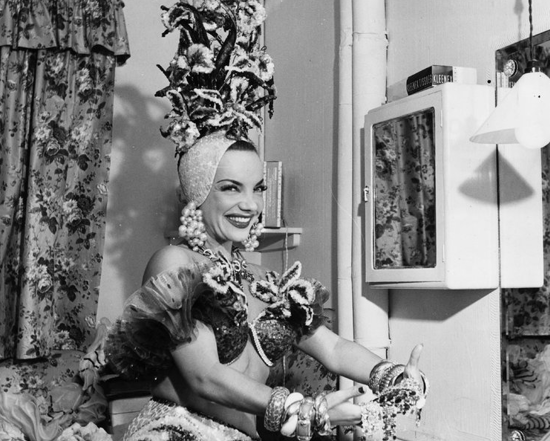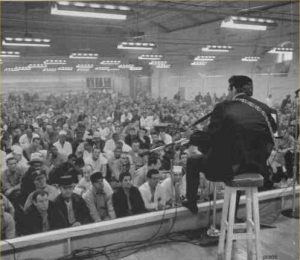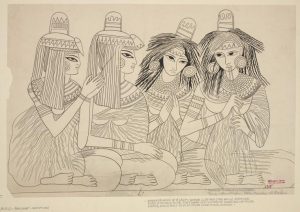Does the name Carmen Miranda sound familiar? What about “the lady in the tutti-frutti hat?” If not, do not feel ashamed, for many have forgotten the excellent Brazilian performer. No Brazilian artist, however, has achieved the international recognition that Carmen Miranda has, especially in Latin America and the States. She was one of the highest-paid women in Hollywood during the 1940’s.1 Yet she is today something of an unknown figure. Why is that?

Well, it dates back to the day she was born. Carmen Miranda was born Maria do Carmo Miranda da Cunha in a village in Portugal on February 9, 1909. She migrated to Brazil with her family in 1910, before turning two years old.2 Though she remained a Portuguese citizen, she was at home in Rio de Janeiro, Brazil. She began performing at a very early age, winning over her family and friends with her talent, and soon she had become a samba sensation. She was cutting records and was a star nearly a whole decade before coming to the United States. One night in 1939, while performing at the famous Cassino da Urca (in a neighborhood in Rio de Janeiro), New York producer Lee Shubert signed her for his show The Streets of Paris on Broadway, and away she went to take the world by surprise.3 While on Broadway, she enchanted everyone with her vibrant singing, dancing, and “Brazilian bombshell” beauty.
At 38 years old she married; however, given the huge persona she was, it is strange that there is not much known about her personal life. The extent of it is that she was raised Catholic, and this may be the reason she married at a mature age. It was rumored that she and her husband, David Sebastian, had a troubled marriage.
It was 1940 when she returned from Broadway to her homeland Brazil, but she was devastated by the way she was received. At the same Casino where Shubert had snatched her from less than a year earlier, Miranda performed to a crowd in awkward silence; only when she began to sing in English did the crowd make some noise, booing. She stopped the show and was so upset that she burst into tears. This incident sent her fleeing from the country, and for about fifteen years she did not return.4
Meanwhile, Miranda spent her time on Broadway and in Hollywood, Las Vegas, and London starring in movies, performing in casinos and clubs, expanding her fame and reputation. She was the tropical beauty from Brazil and there was no one to change her mind about it. Yes, she was a European woman with pale skin and green eyes, but these features are what made her unique, and people found it interesting that a woman like her sang black music. Her unique style gave her the recognition she has acquired as an iconic Latin American. Carmen Miranda was well-known for her outrageously colorful costumes, which called for high platform heels, lots of jewelry, flamboyant dresses, and most famously the turbans with fake fruit stacked so high that it added height to her short stature of 5’0’’. 5 “In Brazil in Bahia, the girls carry the basket with the fruits on her head, and they have big bracelets and big necklaces and they sell fruits in the streets and I take it [my style] from the girls,” Miranda explained as the source of her image.6

For years people have attacked Carmen Miranda on racial grounds. Critics say she had returned to Brazil americanizada. In response, she wrote a song in their mother tongue—the only country in Latin America to speak Portuguese—whose title translates to “They Say I Came Back Americanized.”7 It was also said that she was a sellout and was not truly a native, having been born in Portugal. Some say she was simply portraying the “Brazilian Bombshell” image and embodied the typical stereotype the U.S. public wanted to see in Brazilians, and Latin Americans more generally, where women are highly sexualized. Others argued that her style had created a distorted view of the country, as being sexually exposed, extravagantly colorful, and fruity. They argued that the turbans she wore were not even Brazilian customs and were only used to make fun of her.8 She was even mocked on a Bugs Bunny cartoon. To make matters worse, some said she had no right to sing samba, a music inherited in Brazilian black slums.

On the contrary, Carmen Miranda put Rio de Janeiro on the map of spectacular. She was the most successful person Brazil had produced. In a way, she served as an unofficial ambassador for her country, and it is heavily reflected in her movie roles.9 Everything that was Latin American was a hybrid presented in her performances, her style, her songs, friends and fans. She was everything, and nothing at once: Brazilian, Mexican, Argentinian, Cuban. Hollywood productions during this time period would touch on different cultures, but never fully embrace one, and this may have been what happened to Miranda. She became involved in Franklin D. Roosevelt’s Good Neighbor Policy, which was a program determined to improve relations with the nations of Central and South America.10 She still is the only South American to be immortalized in concrete at Sid Grauman’s Chinese Theatre, “To Sid, VIVA! in the South American Way. Carmen Miranda. March 24th 1941,” neighboring none other than Frank Sinatra. 11 Rio’s Museum of Modern Art welcomed Carmen Miranda with a major retrospective; “Carmen Miranda Forever,” where clips from her movies were shown, and gowns and turbans were showcased. She even had a museum in Rio dedicated to her, the Carmen Miranda Museum. Here, there was a wide variety of arrangements, gowns, costumes, shoes, and anything you can think of that she had performed in. The building itself was not lavish and fabulous as she was. Therefore it did not suit the gems hidden inside. Due to lack of maintenance and funds, it was closed down. It was agreed that Miranda deserved better.12 On the bright side, the museum is being relocated to Rio de Janeiro Museum of Image and Sound, expecting to open anytime soon. 13

It is a difficult task to relate to Carmen Miranda’s plight. She took many chances in leaving Brazil: that of being lost in translation, the crossing of geographical and cultural borders, sounding like herself in a different language, being in a sustained condition of exile. One person could not possibly represent an entire continent, especially one as diverse as that of Latin America with its many rich cultures. Today, it is not rare to be a Brazilian in the United States, in contrast to the way it once was. With that in mind, there is no Brazilian artist that has coped with these issues on the scale that Miranda had to in her prime. A director for a play on Carmen Miranda’s life said it better than anyone: “Carmen hasn’t been forgotten, but she’s been kind of ignored or neglected in recent years.”14 There are people today who have become interested in her, that have opened their minds to who she really was and why she has become an obsolete figure. They will learn that she was a charming, charismatic, comical, and extravagant person, a figure to inspire.15
- Larry Rohter, “Arts Abroad: The Real Carmen Miranda Under the Crown of Fruit,” New York Times, Dec. 13, 2001. Accessed April 13, 2017, http://www.nytimes.com/2001/12/13/theater/arts-abroad-the-real-carmen-miranda-under-the-crown-of-fruit.html. ↵
- Encyclopedia of Latin American History and Culture, 2008, s.v. “Miranda, Carmen (1909-1955),” by John Cohassey. ↵
- Larry Rohter, “Arts Abroad; The Real Carmen Miranda Under the Crown of Fruit,” New York Times, Dec. 13, 2001. Accessed April 13, 2017, http://www.nytimes.com/2001/12/13/theater/arts-abroad-the-real-carmen-miranda-under-the-crown-of-fruit.html. ↵
- Larry Rohter, “Arts Abroad; The Real Carmen Miranda Under the Crown of Fruit,” New York Times, Dec. 13, 2001. Accessed April 13, 2017, http://www.nytimes.com/2001/12/13/theater/arts-abroad-the-real-carmen-miranda-under-the-crown-of-fruit.html. ↵
- Maria Rubia Macedo, “Images of Latin America In the Body and Costumes of Carmen Miranda’s Stylized Baiana: Social Memory and Identity,” Comunicação e Sociedade 24, (2013): 186-209. ↵
- Lulu Garcia-Navarro, “Of Fruit Hats and ‘Happy Tropics,’ A Renaissance for Carmen Miranda,” NPR Parallels, April 22, 2015. Accessed April 13, 2017, http://www.npr.org/sections/parallels/2015/04/22/401467980/of-fruit-hats-and-happy-tropics-a-renaissance-for-carmen-miranda. ↵
- Lulu Garcia-Navarro, “Of Fruit Hats and ‘Happy Tropics,’ A Renaissance for Carmen Miranda,” NPR Parallels, April 22, 2015. Accessed April 13, 2017, http://www.npr.org/sections/parallels/2015/04/22/401467980/of-fruit-hats-and-happy-tropics-a-renaissance-for-carmen-miranda. ↵
- Larry Rohter, “Arts Abroad; The Real Carmen Miranda Under the Crown of Fruit,” New York Times, Dec. 13, 2001. Accessed April 13, 2017, http://www.nytimes.com/2001/12/13/theater/arts-abroad-the-real-carmen-miranda-under-the-crown-of-fruit.html. ↵
- Lulu Garcia-Navarro, “Of Fruit Hats and ‘Happy Tropics,’ A Renaissance for Carmen Miranda,” NPR Parallels, April 22, 2015. Accessed April 13, 2017, http://www.npr.org/sections/parallels/2015/04/22/401467980/of-fruit-hats-and-happy-tropics-a-renaissance-for-carmen-miranda. ↵
- “Good Neighbor Policy,” Office of the Historian, April 13, 2017, https://history.state.gov/milestones/1921-1936/good-neighbor. ↵
- Ralph Morris, “Carmen Miranda, Grauman’s Chinese Theater,” Los Angeles Public Library Photo Collection, Accessed April 13, 2017, https://calisphere.org/item/d381f8bd9fd414dd5661ab0aeeffa4a7/. ↵
- Mac Margnolis, “We Still Have Bananas,” Newsweek (Atlantic Edition) 147, no. 4 (January 23, 2006): 55. ↵
- Lulu Garcia-Navarro, “Of Fruit Hats and ‘Happy Tropics,’ A Renaissance for Carmen Miranda,” NPR Parallels. April 22, 2015. April 13, 2017. http://www.npr.org/sections/parallels/2015/04/22/401467980/of-fruit-hats-and-happy-tropics-a-renaissance-for-carmen-miranda. ↵
- Larry Rohter, “Arts Abroad; The Real Carmen Miranda Under the Crown of Fruit,” New York Times, Dec. 13, 2001. Accessed April 13, 2017, http://www.nytimes.com/2001/12/13/theater/arts-abroad-the-real-carmen-miranda-under-the-crown-of-fruit.html. ↵
- Film clip “Carmen Miranda: ‘Rebola a Bola’ (1941),” from Week-End in Havana, film directed by Walter Lang, 20th Century Fox, 1941. Music by Aloysio de Oliveira and Nestor Amaral, lyrics by Francisco Eugenio Brant Horta, sung in Portuguese by Carmen Miranda. ↵



83 comments
Daniel Gimena
It was interesting to read about Carmen Miranda because, as the author accurately determines at the beginning, I did not know about her. However, it is always great to learn about such talents like Carmen Miranda and how they had to deal with criticism from haters that only wanted to defame a talented person’s reputation.
Kanum Parker
This story tells well of how your looks can change everything even when you’re from there. Miranda was doing well and putting her city on the map but people were upset that she moved to America and changed the standard for Brazilian people because they tend to be dark. At the end people soon forgave her because what she did was saw as good for her city. For this reason we can’t judge too soon on someone who true intent was good.
Paul Garza
I had never heard of Carmen Miranda before reading this article. I really like that this article informs of two different perspectives on Carmen Miranda. The positive reactions she received in the US were totally different to the reactions she received in Brazil. I really like that this article gives enough information that allow the readers to form questions yet still recognize her success.I wonder if she were to rise to fame today, would she be considered someone who profits off of another culture? Would people say she perpetuates a certain cycle of race? Great article!
Kimberly Rubio
It is unfortunate that Carmen Miranda received the backlash she did after becoming famous. She demonstrated a love for performing, even from a young age. While she was loved by many in the United States, I can understand the hurt associated with negative comments from her home country. Especially, because she brought attention to Brazil. She may not have been the representation they wanted, but she remained true to herself. I like that she responded to her critics with the song, “They Say I came Back Americanized.”
Emilia Caballero Carmona
Gabriela your article was so interesting to read! The main picture caught my eye because I felt I had seen that woman before. I think I had seen pictures of Carmen Miranda before in my life, but I never really knew her story. It is so sad that when she went back to her home country, they did not receive her well because they said she was too “Americanized”. It is sad because she did not mean for this to happen. she left her home country to be able to be successful and they offered her opportunities elsewhere.
Brittney Carden
This was such a good article, I was thoroughly engaged. Carmen Miranda is someone I had learned about while taking my two years of Brazilian Portuguese. But, what I was not aware of was the controversial opinions that surrounded her throughout her career. It’s very upsetting to learn about a woman who did so much and broke so many barriers to barely be remembered today.
Meadow Arriaga
This is the first time I hear of Carmen Miranda. She is a talented woman, yet she is not very publicized. This article was very informative to me. I am hispanic and living in America, so I can relate to what she might have been feeling “Americanized”. She faced many people’s criticism and that resulted in an embarrassing event for her.
Hali Garcia
I have seen pictures of Carmen Miranda but I never really knew who she was or what she did. This article really informed me on who she was. Carmen Miranda was a very interesting woman and it is sad that she is unknown. She was incredibly talented but it must have been really hard when she was criticized and accused of abandoning her country and Americanized. What struck me was how she wrote a song addressing being accused of being Americanized.
Samuel Vega
I did not who Carmen Miranda was. I am conflicted by the story. The story describes Carmen has a beautiful and talented woman. It is disappointing that she felt abandoned by the country that she loved. In the 1940s, it was very difficult for women to be seen for more than their beauty. To accomplish what she did; but not to feel loved and appreciated is sad.
Arsema Abera
I have never heard of Carmen Miranda before, but now I know where the fruit hat came from and is praiseful of her motive. While I read this article I was really sad about how the crowd had received her after she came back but felt relief when she found the support that she was looking for. Carmen is truly an icon and should always be remembered.